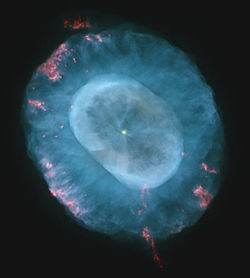|
NGC 7662
NGC 7662 is a planetary nebula located in the northern constellation Andromeda. It is known as the Blue Snowball Nebula, Snowball Nebula, and Caldwell 22. This nebula was discovered October 6, 1784 by the German-born English astronomer William Herschel. In the New General Catalogue it is described as a "magnificent planetary or annular nebula, very bright, pretty small in angular size, round, blue, variable nucleus". The object has an apparent visual magnitude of 8.3 and spans an angular size of 32″ × 28″.[2] Parallax measurements give a distance estimate of 5,730 ± 340 ly (1,757 ± 103 pc).[1] NGC 7662 is a popular planetary nebula for casual observers. A small telescope will reveal a star-like object with slight nebulosity. A 6" telescope with a magnification around 100x will reveal a slightly bluish disk, while telescopes with a primary mirror at least 16" in diameter may reveal slight color and brightness variations in the interior.[4] This nebula has an elliptical shape with a triple-shell structure. The brightest is the main shell, which spans 12″ × 18″. This is surrounded by a fainter outer shell, which has an elliptical form. Both shells are enclosed by a faint, circular halo,[5] some 134″ in diameter. The two shells can be modeled as prolate spheroids, with the inner shell having the greater elongation, a major axis tilt of 50° to the line of sight, and a hull thickness of ~2.5″.[6] Several knots and a jet-like structure are visible, which display emission lines and low ionization. Based on the expansion rate, the estimated age of the nebula is 3,080 years.[5] The central star of the planetary nebula is a subdwarf O star with a spectral type of sdO.[7] The best fit model for this star gives an effective temperature of 100 kK, with 5,250 times the luminosity of the Sun[5] and 60.5% of the Sun's mass.[6] X-ray emission from the nebula is being generated by the stellar wind from this star striking previously ejected matter.[2] Image gallery
See also
References
External links
|
||||||||||||||||||||||||||||

![Hubble Space Telescope image of NGC 7662[8]](http://upload.wikimedia.org/wikipedia/commons/thumb/6/6a/Ngc7662hst.jpg/159px-Ngc7662hst.jpg)